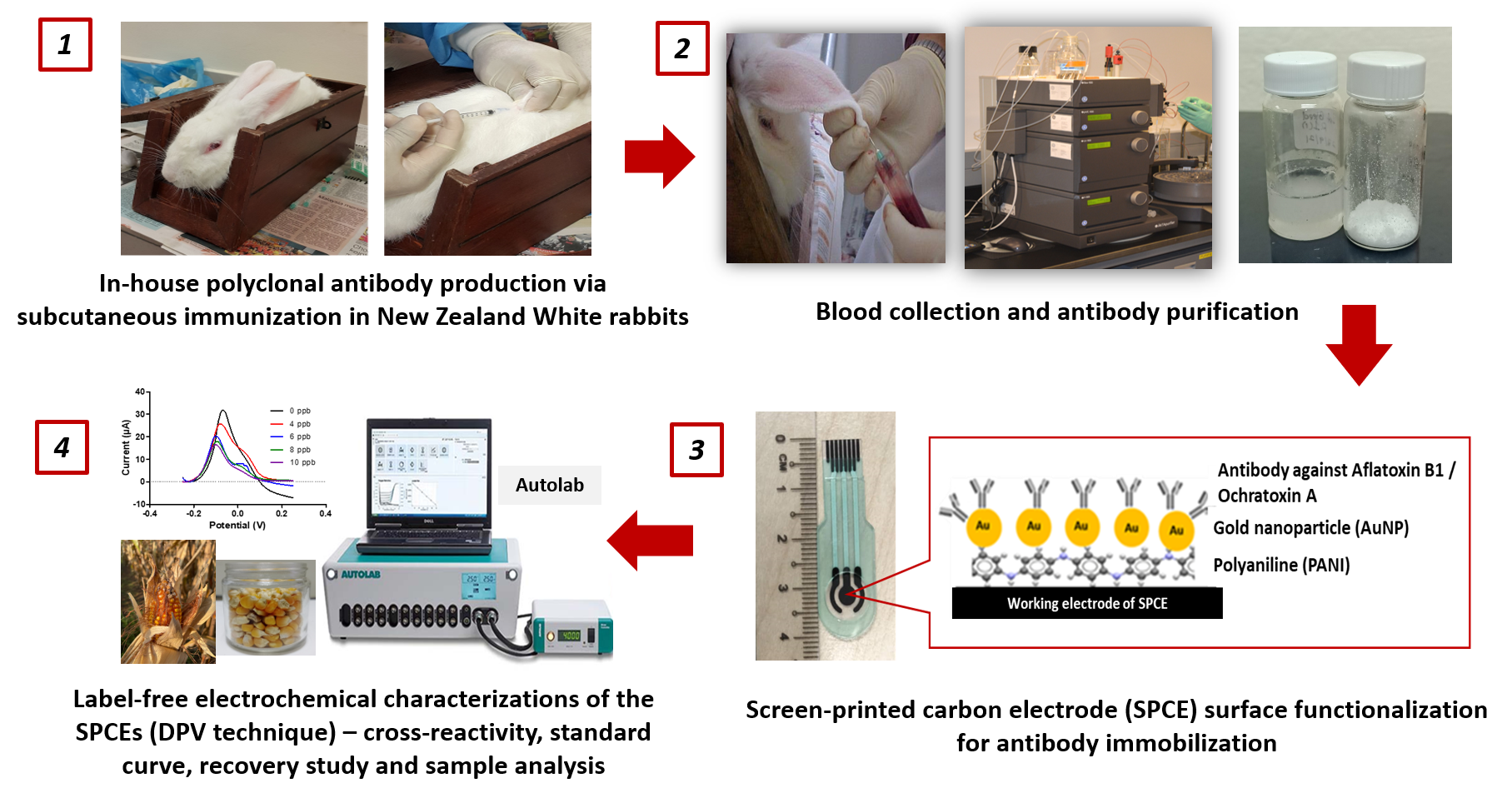Graphical Abstract

1.
Buszewska-Forajta,
M. (2020). Mycotoxins, invisible danger of feedstuff with toxic effect on
animals. Toxicon, 182: 34-53.
2.
Adegbeye,
M, J., Reddy, P. R. K., Chilaka, C. A., Balogun, O.
B., Elghandour, M. M. Y., Rivas-Caceres, R. R. and
Salem, A. Z. M. (2020). Mycotoxin toxicity and residue in animal products:
Prevalence, consumer, exposure and reduction strategies – A review. Toxicon, 177: 96-108.
3.
Afsah-Hejri,
L., Jinap, S., Hajeb, P.,
Radu, S. and Shakibazadeh, S. (2013). A review on
mycotoxins in food and feed: Malaysia case study. Comprehensive Reviews in Food Science and Food Safety, 12: 629-651.
4.
Magnolia,
A. P., Poloni, V. L. and Cavaglieri,
L. (2019). Impact of mycotoxin contamination in the
animal feed industry. Current Opinion in
Food Science, 29: 99-108.
5.
Schaarschmidt,
S. and Fauhl-Hassek, C. (2021). The fate of
mycotoxins during the primary food processing of maize. Food Control, 121: 107651.
6.
Kumar, P., Mahato, D. K., Sharma, B., Borah, R., Haque, S., Mahmud, M.
M. C., Shah, A. K., Rawal, D., Bora, H. and Bui, S. (2020). Ochratoxins in food
and feed: Occurrence and impact on human health and management strategies. Toxicon, 187: 151-162.
7.
Gruber-Dorninger, C., Jenkins, T. and Schatzmayr,
G. (2019). Global mycotoxin occurrence in feed: A ten-year survey. Toxins, 11(375): 1-25.
8.
Kebede, H., Liu, X., Jin, J. and Xing, F. (2020). Current status of major
mycotoxins contamination in food and feed in Africa. Food Control, 110: 106975.
9.
Luo, S., Du, H., Kebede,
H., Liu, Y. and Xing, F. (2021). Contamination status of major mycotoxins in
agricultural product and food stuff in Europe. Food Control, 127: 108120.
10.
Agriopoulou,
S., Stamatelopoulou, E. and Varzakas,
T. (2020). Advances in occurrence, importance, and mycotoxin control
strategies: Prevention and detoxification in foods. Foods, 9 (137): 1-48.
11.
Chiotta,
M. L., Fumero, M. V., Cendoya,
E., Palazzini, J. M., Alaniz-Zanon,
M. S., Ramirez, M. L. and Chulze, S. N. (2020).
Toxigenic fungal species and natural occurrence of mycotoxins in crops
harvested in Argentina. Revista Argentina de Microbiologia,
52 (4): 339-347.
12.
Al-Jaal,
B., Salama, S., Al-Qasmi, N. and Jaganjac,
M. (2019). Mycotoxin contamination of food and feed in the Gulf Cooperation
council countries and its detection. Toxicon,
171: 43-50.
13.
Udomkun,
P., Wiredu, A. N., Nagle, M., Bandyopadhyay, R., Muller, J. and Vanlauwe, B. (2017). Mycotoxins in Sub-Saharan Africa:
Present situation, socio-economic impact, awareness, and outlook. Food Control, 72: 110-122.
14.
Bryden, W. L. (2012).
Mycotoxin contamination of the feed supply chain: Implications for animal
productivity and feed security. Animal
Feed Science and Technology, 173: 134-158.
15.
Munkvold,
G.P., Arias, S., Taschl, I. & Gruber-Dorninger, C. (2019). In Serna-Salvidar,
S.O. (3rd Edition), Corn: Chemistry and Technology (pp. 235-287).
AACC International & Elsevier Inc. Publisher.
16.
Kaushik, A., Arya, S. K.,
Vasudev, A. and Bhansali, S. (2013). Recent advances in detection of ochratoxin
A. Open Journal of Applied Biosensor,
2: 1-11.
17.
Yao, H., Hruska, Z. and Mavungu, D. D. (2015). Developments in detection and
determination of aflatoxins. World
Mycotoxin Journal, 8(2): 181-191.
18.
Roseanu,
A., Jecu, L., Badea, M. and
Evans, R. W. (2010). Mycotoxins: An overview on their quantification methods. Romanian Journal of Biochemistry, 47(1):
79-86.
19.
Moina,
C., & Ybarra, G. (2012). Fundamentals and applications of immunosensors. In
N. H. L. Chiu (Ed.), Advances in
immunoassay technology. Rijeka, Croatia: InTech:
pp. 65–80.
20.
Vidal, J. C., Bonel, L., Ezquerra, A.,
Hernandez, S., Bertolin, J. R., Cubel,
C. and Castillo, J. R. (2013). Electrochemical affinity biosensors for
detection of mycotoxins: A review. Biosensors
and Bioelectronics, 49: 146-158.
21.
Sharma, A., Goud, K. Y.,
Hayat, A., Bhand, S. and Marty, J. L. (2017). Recent
advances in electrochemical-based sensing platforms for aflatoxins detection. Chemosensors, 5
(1): 1-15.
22.
Tothill,
I. E. (2011). Biosensors and nanomaterials and their application for mycotoxin
determination. World Mycotoxin Journal,
4(4): 361-374.
23.
Alhamoud,
Y., Yang, D., Kenston, S. S. F., Liu, G., Liu, L.,
Zhou, H., Ahmed, F. and Zhao, J. (2019). Advances in biosensors for the
detection of ochratoxin A: Bio-receptors, nanomaterials, and their
applications. Biosensors and
Bioelectronics, 141: 111418.
24.
Ma, H., Sun, J., Zhang,
Y., Bian, C., Xia, S. and Zhen, T. (2016). Label-free
immunosensor based on one-step electrodeposition of chitosan-gold nanoparticles
biocompatible film on Au microelectrode for determination of aflatoxin B1 in
maize. Biosensors and Bioelectronics,
80: 222-229.
25.
Shaikh, M. O., Srikanth,
B., Zhu, P.-Y. and Chu, C.-H. (2019). Impedimetric immunosensor utilizing
polyaniline/gold nanocomposite-modified screen-printed electrodes for early
detection of chronic kidney disease. Sensors,
19(18): 3990.
26.
Zhang, S., Shen, Y.,
Shen, G., Wang, S., Shen, G. and Yu, R. (2016). Electrochemical immunosensor
based on Pd-Au nanoparticles supported on functionalized PDDA-MWCNT
nanocomposites for aflatoxin B1 detection. Analytical
Biochemistry, 494: 10-15.
27.
Kabomo,
T. M. and Scurrel, M. S. (2016). The effect of
protonation and oxidation state of polyaniline on the stability of gold
nanoparticles. European Polymer Journal,
82: 300-306.
28.
Yagati,
A. K., Chavan, S. G., Baek, C., Lee, M.-H. and Min,
J. (2018). Label-free impedance sensing of aflatoxin B1 with polyaniline
nanofibers/Au nanoparticle electrode array. Sensors,
18 (1320): 1-14.
29.
Lee, N. A. and Rachmawati, S. (2006). A rapid ELISA for screening
aflatoxin B1 in animal feed and feed ingredients in Indonesia. Food and Agricultural Immunology, 17(2):
91-104.
30.
Nakhjavan,
B., Ahmed, N. S. and Khosravifard, M. (2020).
Development of an improved method of sample extraction and quantitation of
multi-mycotoxin in feed by LC-MS/MS. Toxins,
12(462): 1-14.
31.
Iqbal, S. Z. (2021).
Mycotoxins in food, recent development in food analysis and future challenges;
a review. Current Opinion in Food Science,
42: 237-247.